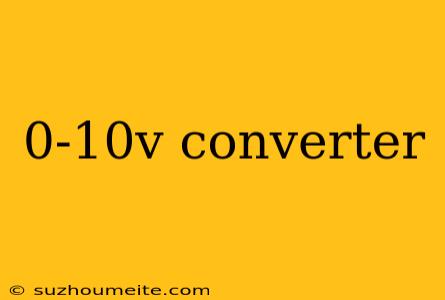0-10V Converter: Understanding the Basics and Applications
Introduction
A 0-10V converter is an electronic device that converts a signal from one format to another, typically from a digital signal to an analog signal, with a range of 0 to 10 volts. This converter is commonly used in industrial automation, process control, and building automation systems to transmit data between devices. In this article, we will delve into the basics of 0-10V converters, their applications, and types.
How 0-10V Converters Work
A 0-10V converter works by taking a digital signal as input, typically from a microcontroller or a digital sensor, and converting it into an analog signal with a voltage range of 0 to 10 volts. This conversion process involves several stages:
Digital-to-Analog Conversion
The digital signal is first converted into a digital code using an analog-to-digital converter (ADC). The ADC samples the digital signal and generates a digital code that represents the signal's amplitude.
Voltage Scaling
The digital code is then sent to a digital-to-analog converter (DAC), which converts the code into an analog voltage signal. The DAC scales the voltage signal to a range of 0 to 10 volts.
Analog Signal Output
The final stage of the conversion process involves amplifying and filtering the analog signal to remove any noise or distortion. The resulting signal is a clean, analog voltage signal with a range of 0 to 10 volts.
Applications of 0-10V Converters
0-10V converters have a wide range of applications in various industries, including:
Industrial Automation
0-10V converters are used to transmit data between devices in industrial automation systems, such as between sensors, actuators, and controllers.
Process Control
In process control systems, 0-10V converters are used to transmit data between devices such as temperature sensors, pressure sensors, and flow meters.
Building Automation
0-10V converters are used in building automation systems to transmit data between devices such as temperature sensors, humidity sensors, and lighting controllers.
Types of 0-10V Converters
There are several types of 0-10V converters available, including:
Isolated Converters
Isolated converters provide electrical isolation between the input and output signals, making them suitable for use in high-voltage applications.
Non-Isolated Converters
Non-isolated converters do not provide electrical isolation and are suitable for use in low-voltage applications.
Digital-to-Analog Converters
Digital-to-analog converters convert digital signals directly to analog signals without the need for voltage scaling.
Conclusion
In conclusion, 0-10V converters play a crucial role in industrial automation, process control, and building automation systems. By converting digital signals to analog signals with a range of 0 to 10 volts, these converters enable the transmission of data between devices. Understanding the basics and applications of 0-10V converters is essential for designing and implementing efficient and reliable automation systems.
